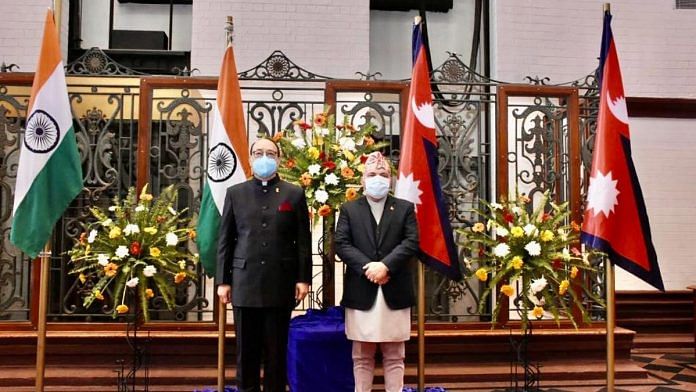New Delhi: Six months after the controversy over the Kalapani-Lipulekh border issue and Nepal’s new map, Foreign Secretary Harsh Vardhan Shringla has said he intends to take India’s bilateral ties with its Himalayan neighbour forward.
Shringla is on a two-day visit to Nepal starting Thursday, his first to the country as India’s foreign secretary, and is set to meet Prime Minister K.P. Sharma Oli and Foreign Minister Pradeep Gyawali. He also met his Nepalese counterpart, Bharat Paudyal.
FS @harshvshringla had a productive meeting with @PaudyalBR during which they took stock of bilateral cooperation and discussed issues of mutual interest.#IndiaNepalFriendship @MEAIndia @PMOIndia [1/2] pic.twitter.com/NXgnxoahoV
— IndiaInNepal (@IndiaInNepal) November 26, 2020
The visit comes at a time when Nepal has witnessed protests for the restoration of the monarchy, 12 years after the royals were shown the door and the country became a federal democratic republic.
“I wanted to come here earlier too, but because of Covid, we could not do so… We have a very strong relationship. Our endeavour will be to see how we can take the relationship forward. We have some very good meetings ahead of us,” Shringla said upon reaching Kathmandu Thursday morning. Notably, he spoke in fluent Nepali.
Also read: Mocking Indian emblem, redrawing Nepal map, KP Oli’s adventures are growing
Relations at a low point
Shringla’s visit is being seen as maintaining the “tradition of regular high-level exchanges between the two countries and the priority India attaches to its relations with Nepal”, according to the Ministry of External Affairs.
However, his visit assumes critical importance because since May 2020, India-Nepal relations have entered one of their lowest phases ever over the Kalapani border dispute.
Sources said the Kalapani border issue is on agenda, but a formal round of negotiations at the level of foreign secretaries will only be announced next month when Nepal Foreign Minister Gyawali visits India to hold the sixth Joint Commission meeting between the countries with his counterpart S. Jaishankar.
In May, Defence Minister Rajnath Singh inaugurated a motorable road to the Lipulekh pass through the Pithoragarh district of Uttarakhand, for the use of Kailash-Mansarovar pilgrims. He said the road is “within the territory of India”.
Nepal then objected to the road, claiming Lipulekh as part of its own territory, and even handed over a diplomatic note to the Indian envoy in Kathmandu, Vinay Mohan Kwatra.
Nepal then upped the ante by releasing a new political map, showing 335 sq km of territory in the disputed Kalapani-Lipulekh-Limpiyadhura region as part of its own territory. New Delhi rejected this claim.
Pro-monarchy protests in Nepal on eve of visit
Meanwhile, on the eve of Foreign Secretary Shringla’s visit, Nepal saw large-scale protests in the cities of Janakpur and Pokhara, demanding a return to a monarchic system.
Nepal announced an end to its 240-year-old monarchy in May 2008, and became a federal democratic republic. However, since then, protests over bringing back the monarchy have continued.
The latest protests come at a time when Nepal has seen domestic turmoil too, with severe infighting between two factions of the ruling Nepal Communist Party — one led by PM Oli and the other by former PM Pushpa Kamal Dahal ‘Prachanda’. The factions have been squabbling over a power-sharing deal.
The Prachanda faction has demanded Oli’s resignation as the party’s chairman, while Oli has alleged his detractors are working against him “with India’s help”.
Foreign Secretary Shringla’s trip follows earlier ones by Indian Army chief Gen. M.M. Naravane, and a whirlwind tour by RAW chief Samant Kumar Goel to Kathmandu, in a bid to mend ties. However, Goel’s visit had led to reports in the Nepali media that claimed India is planning to oust Oli and create a different power axis.
Also read: Modi said Neighbourhood First and then ranked Nepal low in India’s priority list



